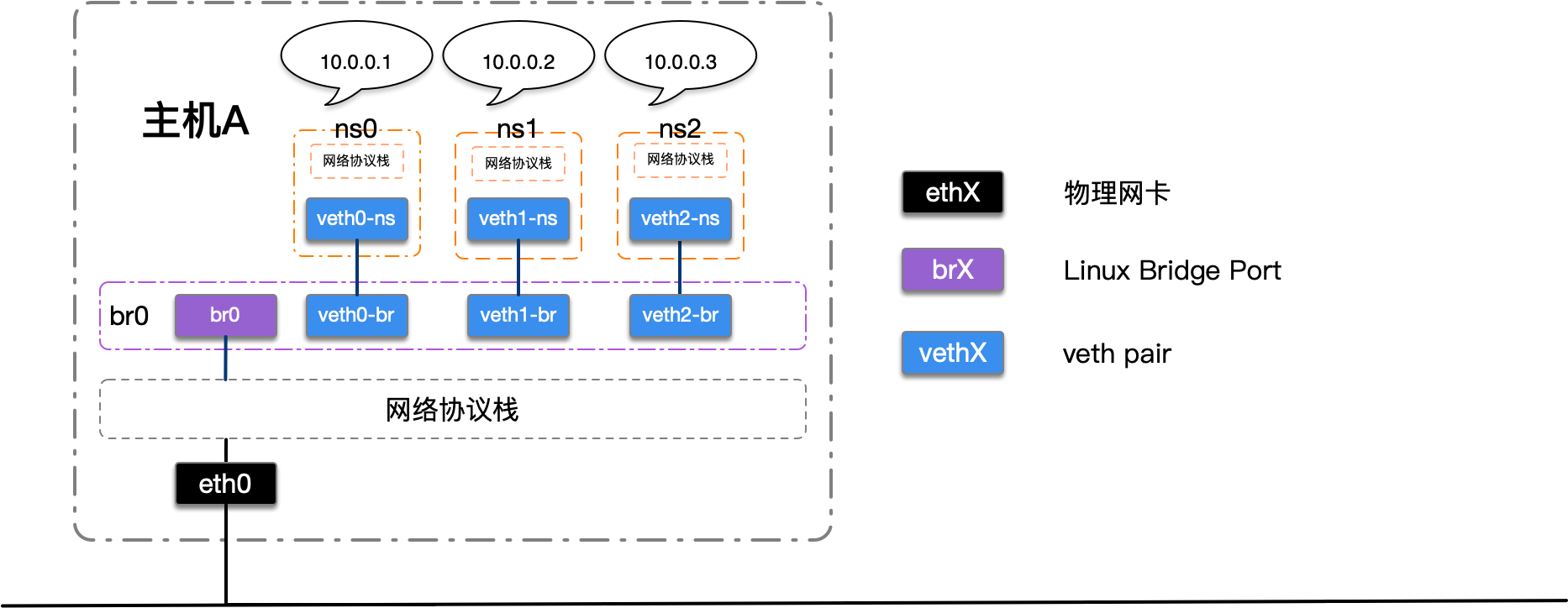Linux Bridge 详解
Linux Bridge(网桥)是用纯软件实现的虚拟交换机,有着和物理交换机相同的功能,例如二层交换,MAC地址学习等。因此我们可以把tun/tap,veth pair等设备绑定到网桥上,就像是把设备连接到物理交换机上一样。此外它和veth pair、tun/tap一样,也是一种虚拟网络设备,具有虚拟设备的所有特性,例如配置IP,MAC地址等。
Linux Bridge通常是搭配KVM、docker等虚拟化技术一起使用的,用于构建虚拟网络,因为此教程不涉及虚拟化技术,我们就使用前面学习过的netns来模拟虚拟设备。
如何使用Linux Bridge?
操作网桥有多种方式,在这里我们介绍一下通过bridge-utils来操作,由于它不是Linux系统自带的工具,因此需要我们手动来安装它。
# centos
yum install -y bridge-utils
# ubuntu
apt-get install -y bridge-utils
使用brctl help查看使用帮助
never heard of command [help]
Usage: brctl [commands]
commands:
addbr <bridge> add bridge
delbr <bridge> delete bridge
addif <bridge> <device> add interface to bridge
delif <bridge> <device> delete interface from bridge
hairpin <bridge> <port> {on|off} turn hairpin on/off
setageing <bridge> <time> set ageing time
setbridgeprio <bridge> <prio> set bridge priority
setfd <bridge> <time> set bridge forward delay
sethello <bridge> <time> set hello time
setmaxage <bridge> <time> set max message age
setpathcost <bridge> <port> <cost> set path cost
setportprio <bridge> <port> <prio> set port priority
show [ <bridge> ] show a list of bridges
showmacs <bridge> show a list of mac addrs
showstp <bridge> show bridge stp info
stp <bridge> {on|off} turn stp on/off
常用命令如
新建一个网桥:
brctl addbr <bridge>
添加一个设备(例如eth0)到网桥:
brctl addif <bridge> eth0
显示当前存在的网桥及其所连接的网络端口:
brctl show
启动网桥:
ip link set <bridge> up
删除网桥,需要先关闭它:
ip link set <bridge> down
brctl delbr <bridge>
或者使用ip link del 命令直接删除网桥
ip link del <bridge>
增加Linux Bridge时会自动增加一个同名虚拟网卡在宿主机器上,因此我们可以通过
ip link命令操作这个虚拟网卡,实际上也就是操作网桥,并且只有当这个虚拟网卡状态处于up的时候,网桥才会转发数据。
实验
在上一节《Linux veth pair详解》我们使用veth pair将两个隔离的netns连接在了一起,在现实世界里等同于用一根网线把两台电脑连接在了一起,但是在现实世界里往往很少会有人这样使用。因为一台设备不仅仅只需要和另一台设备通信,它需要和很多很多的网络设备进行通信,如果还使用这样的方式,需要十分复杂的网络接线,并且现实世界中的普通网络设备也没有那么多网络接口。
那么,想要让某一台设备和很多网络设备都可以通信需要如何去做呢?在我们的日常生活中,除了手机和电脑,最常见的网络设备就是路由器了,我们的手机连上WI-FI,电脑插到路由器上,等待从路由器的DHCP服务器上获取到IP,他们就可以相互通信了,这便是路由器的二层交换功能在工作。Linux Bridge最主要的功能就是二层交换,是对现实世界二层交换机的模拟,我们稍微改动一下网络拓扑,如下图:

我们建立了一个网桥,三个netns,三对veth pair,分别一端在netns中,另一端连接在网桥上,为了简化拓扑,我去除了netns中的tap设备,将IP直接配置在veth上。
veth设备不仅仅可以可以充当“网线”,同时它也可以当作虚拟网卡来使用。
# 添加网桥
brctl addbr br0
# 启动网桥
ip link set br0 up
# 新增三个netns
ip netns add ns0
ip netns add ns1
ip netns add ns2
# 新增两对veth
ip link add veth0-ns type veth peer name veth0-br
ip link add veth1-ns type veth peer name veth1-br
ip link add veth2-ns type veth peer name veth2-br
# 将veth的一端移动到netns中
ip link set veth0-ns netns ns0
ip link set veth1-ns netns ns1
ip link set veth2-ns netns ns2
# 将netns中的本地环回和veth启动并配置IP
ip netns exec ns0 ip link set lo up
ip netns exec ns0 ip link set veth0-ns up
ip netns exec ns0 ip addr add 10.0.0.1/24 dev veth0-ns
ip netns exec ns1 ip link set lo up
ip netns exec ns1 ip link set veth1-ns up
ip netns exec ns1 ip addr add 10.0.0.2/24 dev veth1-ns
ip netns exec ns2 ip link set lo up
ip netns exec ns2 ip link set veth2-ns up
ip netns exec ns2 ip addr add 10.0.0.3/24 dev veth2-ns
# 将veth的另一端启动并挂载到网桥上
ip link set veth0-br up
ip link set veth1-br up
ip link set veth2-br up
brctl addif br0 veth0-br
brctl addif br0 veth1-br
brctl addif br0 veth2-br
测试网络连通性
使用ip netns exec ns0 ping 10.0.0.2在命名空间ns0中测试与ns1的10.0.0.2的网络连通性
PING 10.0.0.2 (10.0.0.2) 56(84) bytes of data.
64 bytes from 10.0.0.2: icmp_seq=1 ttl=64 time=0.032 ms
64 bytes from 10.0.0.2: icmp_seq=2 ttl=64 time=0.058 ms
64 bytes from 10.0.0.2: icmp_seq=3 ttl=64 time=0.052 ms
64 bytes from 10.0.0.2: icmp_seq=4 ttl=64 time=0.044 ms
^C
--- 10.0.0.2 ping statistics ---
4 packets transmitted, 4 received, 0% packet loss, time 54ms
rtt min/avg/max/mdev = 0.032/0.046/0.058/0.011 ms
使用ip netns exec ns0 ping 10.0.0.3在命名空间ns0中测试与ns2的10.0.0.3的网络连通性
PING 10.0.0.3 (10.0.0.3) 56(84) bytes of data.
64 bytes from 10.0.0.3: icmp_seq=1 ttl=64 time=0.054 ms
64 bytes from 10.0.0.3: icmp_seq=2 ttl=64 time=0.045 ms
64 bytes from 10.0.0.3: icmp_seq=3 ttl=64 time=0.058 ms
64 bytes from 10.0.0.3: icmp_seq=4 ttl=64 time=0.064 ms
^C
--- 10.0.0.3 ping statistics ---
4 packets transmitted, 4 received, 0% packet loss, time 81ms
rtt min/avg/max/mdev = 0.045/0.055/0.064/0.008 ms
使用ip netns exec ns1 ping 10.0.0.1在命名空间ns1中测试与ns0的10.0.0.1的网络连通性
PING 10.0.0.1 (10.0.0.1) 56(84) bytes of data.
64 bytes from 10.0.0.1: icmp_seq=1 ttl=64 time=0.031 ms
64 bytes from 10.0.0.1: icmp_seq=2 ttl=64 time=0.046 ms
64 bytes from 10.0.0.1: icmp_seq=3 ttl=64 time=0.038 ms
64 bytes from 10.0.0.1: icmp_seq=4 ttl=64 time=0.041 ms
^C
--- 10.0.0.1 ping statistics ---
4 packets transmitted, 4 received, 0% packet loss, time 81ms
rtt min/avg/max/mdev = 0.031/0.039/0.046/0.005 ms
使用ip netns exec ns1 ping 10.0.0.3在命名空间ns1中测试与ns2的10.0.0.3的网络连通性
PING 10.0.0.3 (10.0.0.3) 56(84) bytes of data.
64 bytes from 10.0.0.3: icmp_seq=1 ttl=64 time=0.060 ms
64 bytes from 10.0.0.3: icmp_seq=2 ttl=64 time=0.059 ms
64 bytes from 10.0.0.3: icmp_seq=3 ttl=64 time=0.044 ms
64 bytes from 10.0.0.3: icmp_seq=4 ttl=64 time=0.065 ms
^C
--- 10.0.0.3 ping statistics ---
4 packets transmitted, 4 received, 0% packet loss, time 65ms
rtt min/avg/max/mdev = 0.044/0.057/0.065/0.007 ms
使用ip netns exec ns2 ping 10.0.0.1在命名空间ns2中测试与ns0的10.0.0.1的网络连通性
PING 10.0.0.1 (10.0.0.1) 56(84) bytes of data.
64 bytes from 10.0.0.1: icmp_seq=1 ttl=64 time=0.032 ms
64 bytes from 10.0.0.1: icmp_seq=2 ttl=64 time=0.056 ms
64 bytes from 10.0.0.1: icmp_seq=3 ttl=64 time=0.043 ms
64 bytes from 10.0.0.1: icmp_seq=4 ttl=64 time=0.060 ms
^C
--- 10.0.0.1 ping statistics ---
4 packets transmitted, 4 received, 0% packet loss, time 69ms
rtt min/avg/max/mdev = 0.032/0.047/0.060/0.013 ms
使用ip netns exec ns2 ping 10.0.0.2在命名空间ns2中测试与ns1的10.0.0.2的网络连通性
PING 10.0.0.2 (10.0.0.2) 56(84) bytes of data.
64 bytes from 10.0.0.2: icmp_seq=1 ttl=64 time=0.030 ms
64 bytes from 10.0.0.2: icmp_seq=2 ttl=64 time=0.055 ms
64 bytes from 10.0.0.2: icmp_seq=3 ttl=64 time=0.044 ms
64 bytes from 10.0.0.2: icmp_seq=4 ttl=64 time=0.042 ms
^C
--- 10.0.0.2 ping statistics ---
4 packets transmitted, 4 received, 0% packet loss, time 114ms
rtt min/avg/max/mdev = 0.030/0.042/0.055/0.011 ms
可以看到我们通过网桥的方式把三个隔离的netns连接在了一起,通过这种方式,我们还可以很方便的添加第四个netns,第五个netns…在这里我们就不展开了,感兴趣的同学可以尝试一下。
接下来我们来讲解一下docker的几种网络模式。